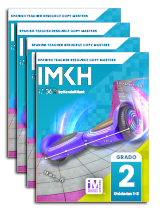Search Listing Name
product:
Project M3: Level 3-4: Unraveling The Mystery of The MoLi Stone: Exploring Place Value and Numeration Student Mathematician's Journal
The Student Mathematician’s Journal allows students to explore simulated or real-life problems and help them to think, write, and read like mathematicians. It encourages students to reflect on what they have learned in each lesson, think deeply about mathematics, and communicate in writing on worksheets.
In this unit, students explore our numeration system in depth and discover a stone with unusual

product:
IM v.360: Grade 2 Spanish Teacher Resource Copy Master Set
IM® v.360 K-5 Math is an IM Certified curriculum providing trusted, highly rated materials to ensure students thrive in mathematics. Each Illustrative Mathematics lesson has four phases, from pre-unit practice modules to cool downs, focusing students’ attention on definitions, notations, and graphical conventions contributing to the development of real numbers.
Grade 2
The big ideas in grade 2 include: extending understanding of the base-ten number system, building fluency with addition and subtraction, using standard units of mea
product:
Navigator Heritage Series: Memory String Novel Study Guide 1 Year License
Family is the center of The Memory String which tells the story of Laura, a young girl living with her father and stepmother. Through illustrations the reader dives into the life of Laura who was given a memory string from her mother who recently passed away. Each button on the memory string represents a piece of her family’s history. One day, the memory string breaks, causing Laura, her father, and stepmother to search frantically for the missing buttons. It is then that Laura realizes her memory string has the ability to help her collect new memories in


